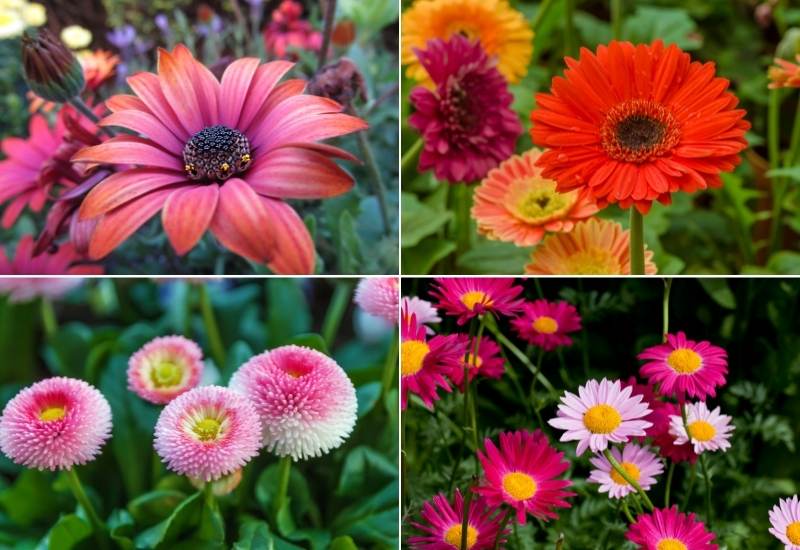
Daisies fill lawns and prairies all over the world with their beautiful, multi-petaled flowers that look like tiny stars; they grow in almost every garden, where they bloom profusely, sometimes for months on end, opening their flowery eyes in the morning and closing their “eyelids” as the Sun sets…
Daisies are, arguably, one of the best known, most loved and most easily recognizable flowers of all…
White, yellow, red and pink, there are daisies of so many different colors and types, but how many?
There are a whopping 20,000 species of daisies, some small and white, some showy and colorful. The six most popular daisy types are coneflowers, gerbera daisies, Shasta and Bellis daisies, African daisies, gloriosa daisies and marguerites. Within each group, there are many varieties to choose from.
Everybody loves daisy flowers, but with 20,000 varieties, it will be difficult to choose the one that’s perfect for you and your garden…
To help you narrow down your choices, we have composed a list of different types of daisies, along with some classification info and few examples of daisy flower varieties from each group.
Read in and you will meet each one in turn, with handy tips on how to grow different daisy cultivars.
What Is a Daisy?
All daisies are flowers but not all flowers are daisies. So, what distinctive features tell you that the beauty you are staring at is a daisy?
Well, to start with, daisies must have flowers that open around sunrise and close at about sunset. You will see them start to fold their little petals just as the Sun approaches the horizon.
In fact, the name itself means “the eye of the day”, from the Anglo-Saxon (a.k.a. Old English) dæges ēage, “of the day the eye”, literally.
Daisies also need to have a central disk and what appear to be petals all around. But this is not scientifically correct…
Actually a daisy is not a flower… Sorry to disappoint you… One of the most iconic flowers of all is actually an inflorescence…
Look closely at a daisy and you will see that each of the many spots inside the disk is actually a tubular flower. Each of these flowers will produce a single seed. A bit like sunflowers, only much smaller.
The flowers all around the central disk, though, have something special; they have one modified long petal called a ligule. That’s what we usually take for petals, and in a way they are, but each comes from a single flower around the disk, called ray flower.
So, each daisy is made up of many disk flowers in the middle and a few ray flowers all around the edge of the disk. Under the ray flowers you have what look a bit like sepals, usually green, but they are not sepals…
They are called phyllaries because they don’t protect a petal, but the receptacle of all the petals, which is that kind of flat bowl you have under all these tiny flowers.
So, with daisies things are not exactly as most people think…
But now you know what a daisy actually is, even before we move into the list of wonderful varieties, let’s spend a few words on the most iconic, most common and maybe the set west of them all, the common daisy…
30 Different Types Of Daisies for Dramatic Color All Season Long
Let me tell you that choosing only 30 varieties out of the 20,000 plus we know of has not been an easy job.
But after long considerations, the names of the ones that have made the final cut have come through, and here they are, divided in to groups.
We’ll see each one in detail in a jiffy, but first, let’s talk a bit about what makes a flower a daisy.
While definitely not complete, following is a selection of 30 colorful types of daisies that’ll brighten your garden
common English daisy (Bellis perennis)
Oddly named in Latin, as it means “eternal war”, the common daisy we see in lawns and low prairies all over the world, in temperate regions, is that white flower with a bright yellow center that sometimes turns purplish, especially late in the season.
It will only grow to about 10 cm tall (3 inches), but its strength is in numbers; they can carpet a whole grassy knoll with their beautiful white beards, making it look like the sky at night crossed by the Milky Way.
Original of Europe, it is very hardy and it has become naturalized all over the world, as it propagates fast.
If scientists have been somewhat cruel and unfair in naming this flower, popular culture has given it much more respect, and elected it to the symbol of innocence and purity in flower language and symbolism.
This may be why if you ask a group of children, I bet you that you’ll find out that it’s their most beloved flower.
Echinacea Daisies
This group of daisies takes its name from the fact that the central disk, the one with the many tubular flowers, is not flat. Instead, it looks a bit like a more or less pointed cone, just like those that pines produce.
They come from the Americas, where they are the most iconic flowers of prairies. Like most flowers that grow in wild prairies, they are very hardy and strong, which makes growing them very easy and low maintenance.
But recently, they have come into the limelight for another reason: many of them (if not all), have outstanding medicinal properties.
Echinacea, in fact, has the ability of boosting your immune system, which makes it ideal to treat and cure a wide range of ailments.
1. Coneflower ‘PowWow Wild Berry’ (Echinacea Pursuer ‘Powwow Wild Berry’)
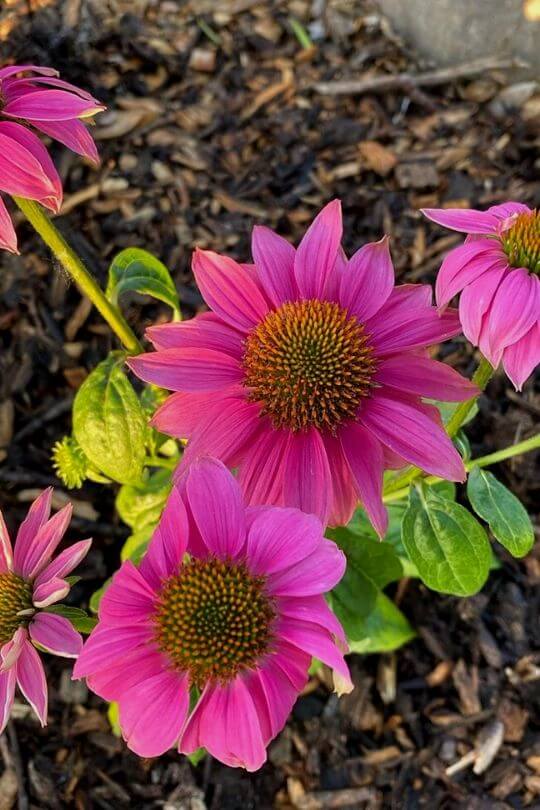
Talking of oddly named daisies, coneflower ‘PowWow Wild Berry’ is more regal and luxurious looking than the name would suggest, with showy magenta blossoms that have made it a gold medal contender of the All-America Selections in 2010.
The blooms of this coneflower cultivar are generous and come very early compared with other similar daisies, usually starting in late spring.
The flowers are large, up to 4 inches wide, or 10 cm, and, with the vibrancy of their color, and proud appearance, they can bring a touch of class and warmth to your flower beds, borders grown in clumps.
They would also look stunning in cottage gardens and wild meadow, where you can scatter them more sparsely among other flowers and herbaceous plants, but the good news is that you can even keep them on your terrace, growing them in a container.
2. ‘Cheyenne Spirit’ Coneflower (Echinacea ‘Cheyenne Spirit’)
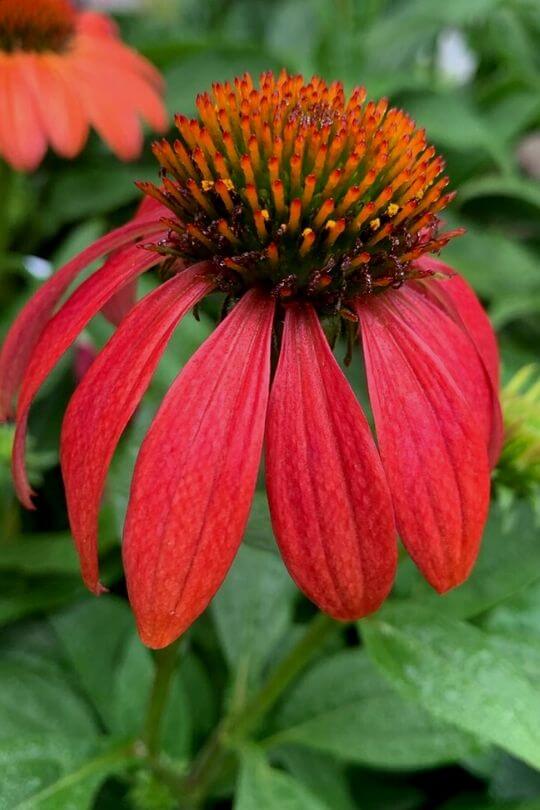
Weave the colors of a Native American fabric pattern into your garden with ‘Cheyenne Spirit’ Coneflower! This wonderful daisy flower variety looks well in large groups, where it can express all the warm colors of its flowers, which can be light yellow, dark yellow, orange, red or garnet.
This award winning Echinacea is an outstanding choice if you want vibrancy, splashes of color and vitality even if you are not a great gardener, in fact, it will tolerate drought, rocky soil, and even deer will leave it alone.
It can lift any border or flower bed with its showy blooms, each flower being up to 4 inches wide (10 cm), but it can also turn a coy meadow into a homage to the Sun and his colors, or any informal garden actually.
3. ‘Sombrero Adobe Orange’ Coneflower (Echinacea ‘Sombrero Adobe Orange’)
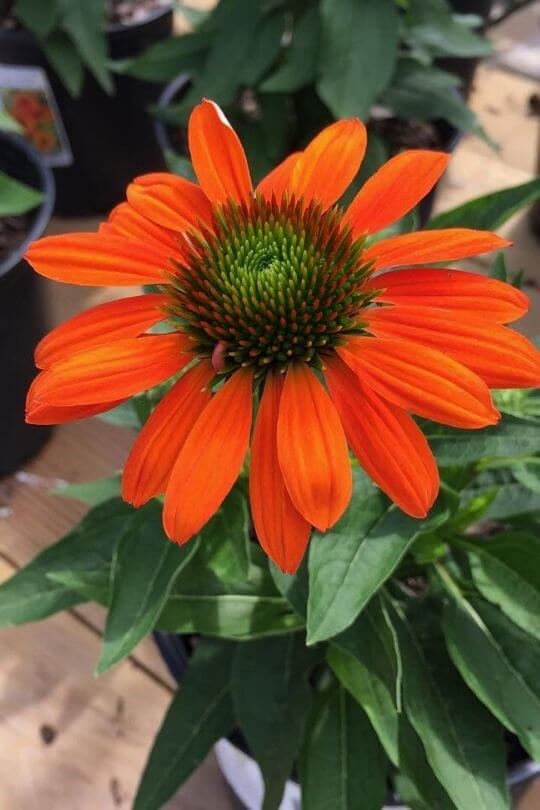
This variety of coneflower daisy is notable for its vibrant and warm orange petals, a color which is also taken up by the tips of the disk flowers, which are copper below the edges.
The petals are also quite large for a cone flower, which makes this variety softer looking, more romantic and less wild in appearance.
It will bloom from late spring for long, well into the summer, and sometimes, it may even give flowers till the first frost.
With many dense flowers, ‘Sombrero Adobe Orange’ is ideal if you want to charge an area of your garden (in a bed, border, prairie area or wild meadow) with a thick, warm and vibrant patch of color.
4. Pale Purple Coneflower (Echinacea Pallida)
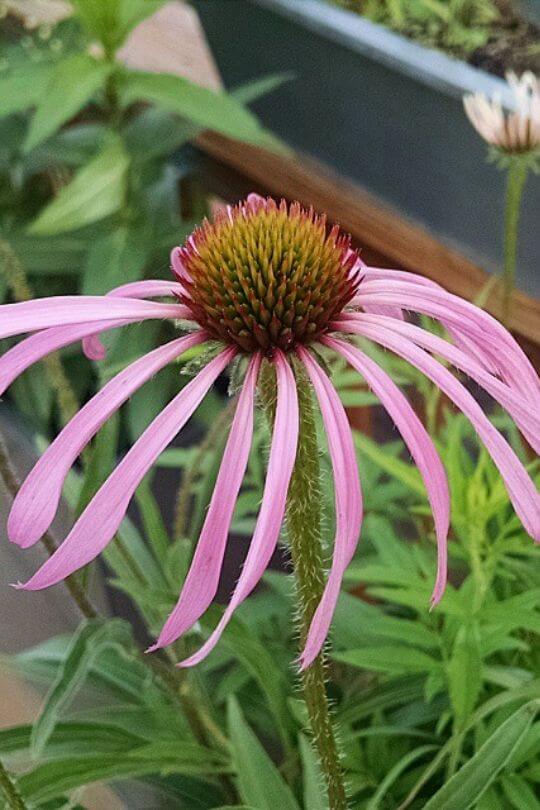
A coneflower daisy with a different look from the previous one, pale purple coneflower has long, distanced petals that look like strips of pale mauve purple paper, which start darker towards the disk and then turn off white.
This species is perfect for the wild but romantic garden feel, for wild meadows, borders, or large flower beds.
With long blooms that will last the whole summer and its tolerance to dry soil, clay soil, rocky soil and even deer, this beautiful daisy will solve many problems with little effort or maintenance.
5. Coneflower ‘Hope’ (Echinacea Purpurea ‘Hope’)
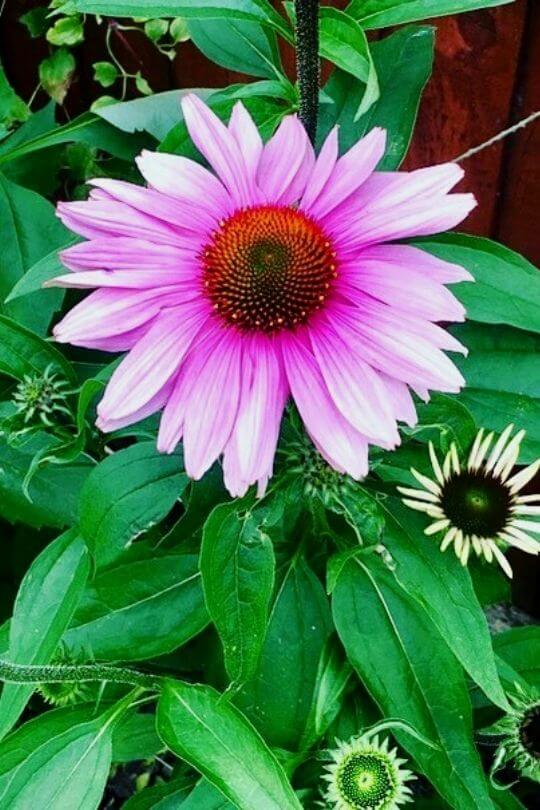
This coneflower daisy also has mauve petals, but they are plenty and sometimes overlap. The disk is very large, of a fiery orange shade, which gives the flower a very harmonic look, as the disk is exactly 1/3 of the width of the large flower, which reaches 4 inches in diameter (10 cm).
These showy blooms will last through the summer, giving your borders, wild meadows, flower beds or cottage garden a very elegant and balanced appearance.
6. Coneflower ‘Green Jewel’ (Echinacea Purpurea ‘Green Jewel’)
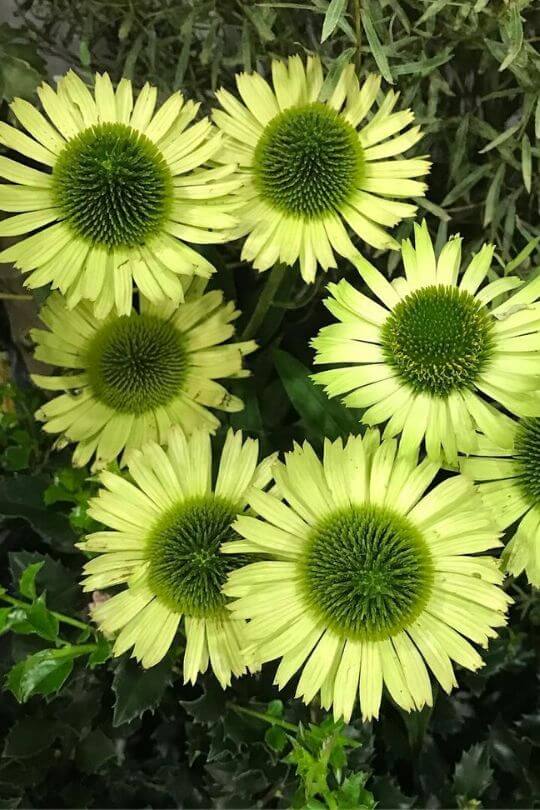
If you fancy an unusual looking coneflower daisy, with an exceptional shade of chartreuse yellow to green petals, which sometimes turn more towards the green side of the spectrum, coneflower ‘green jewel’ is the perfect choice for you.
This coneflower has petals that start slim and then widen and arch slightly downward, a very glossy appearance and it looks a bit like a flower from a sci-fi movie, or from outer space, thanks to its “lunar glow”.
You may like it in your beds, borders or wild meadows, but this fond flower needs the right setting to extol its idiosyncratic beauty; it would be hard to combine it with other colors, and, in my view, it looks better on its ow, or with some very light mauve flowers, like pale purple coneflower.
7. Cornflower ‘Doubledecker’ (Echinacea Purpurea ‘Doubledecker’)
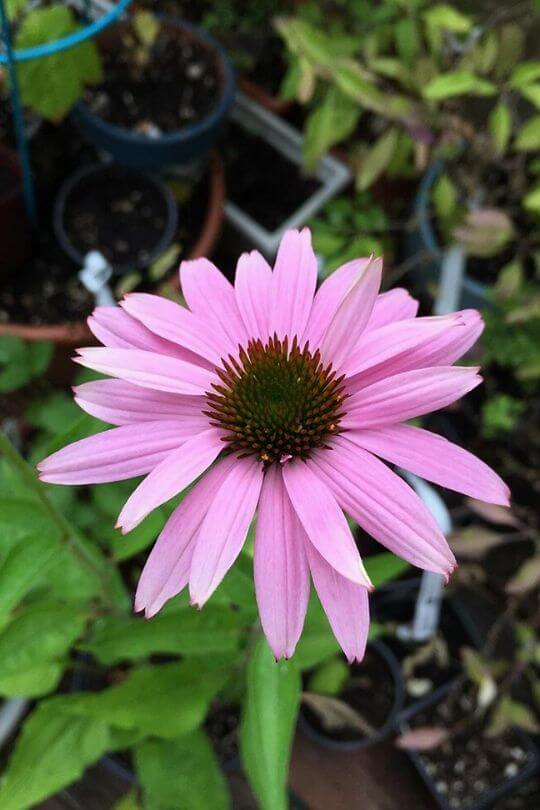
This coneflower daisy is unique, but not for the coloring of its flowers, but for the fact that it has two tiers of petals: the ring petals, like all other coneflowers, that point down, then an extra ring of shorter petals towards the top of the ring.
This gives the flower a wedding day look, which is also carried by the rich pink shade of the petals themselves. So, no need to say that it would look in a romantic corner of your garden, be it in a flower bed, border or wild meadow.
Gerbera Daisies
Gerbera is a genus of plants, raises in fact, with very showy flowers, which often but not always, have the ring of the same color as the outer petals.
The African lily (Agapanthus spp.) genus consists of about 10 species of flowering, evergreen plants
This gives them a very comforting appearance, which has made them popular with gardeners all over the world as well as florists, who love to sell them as cut flowers.
Gerbera daisies also add very rich foliage to the beauty and very defined colors of their flowers.
The leaves, large and with waving and “pinnatisect” margins (which means that they have opposing lobes), grow at the base of the plant to form a bush like clump, while the flower bearing stems grow taller than the leaves, and divide the colorful bloom above from the lower foliage.
This gives them amazing architectural and aesthetic properties which gardeners appreciate, and which makes them ideal for flower beds as well as containers.
Gerbera daisies are tender perennials consists of more than 40 varieties.
8. Gerbera Daisy ‘Jaguar Rose Picotee’ (Gerbera Jamesonii ‘Jaguar Rose Picotee’)
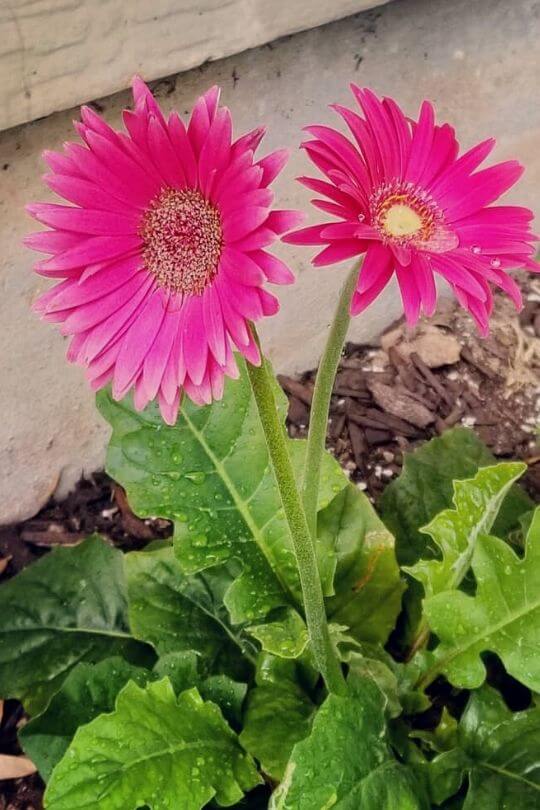
This sweet looking Gerbera daisy has a very rich and vibrant but pastel fuchsia pink shade in its petals that it can bring to life even the dullest corner of your garden, terrace or patio.
The ring is pink too, giving it that “wholesome look” that many gerbera daisies are.
These romantic but bold flowers will blossom from spring to autumn, with many flowers at the same time for each plant.
It can become a small but cheeky protagonist in wild looking beds and borders, but also on its own in containers or in courtyard gardens, even by the side of a wall.
9. Gerbera Daisy ‘Sweet Memory’ (Gerbera Gavinea ‘Sweet Memory’)
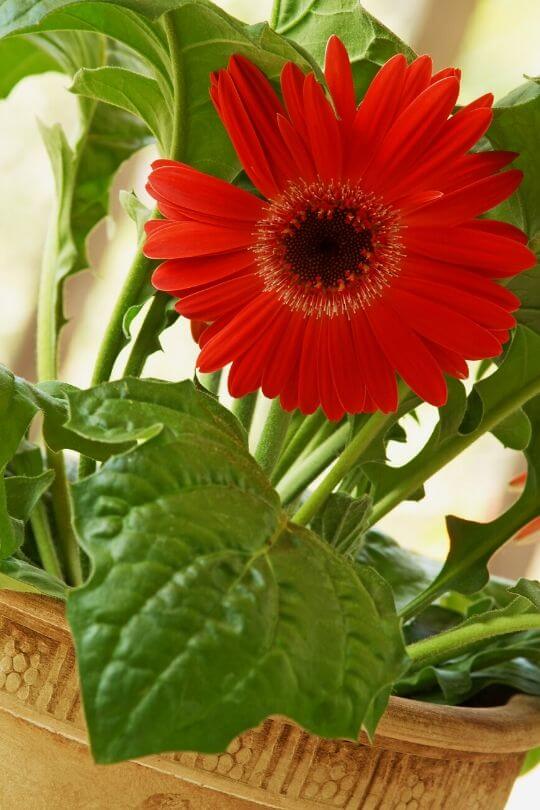
The flowers of this gerbera daisy look like they come out of the palette of a very bold and creative painter; in fact, they have a deep hot pink shade in the middle of the petals, but the edges frame them nicely with a thin white rim.
There are two rows of these petals around the ring, but then, this flower adds a few rows of shorter and lighter, lemonade pink petals between the ring and the disk, where the flowers are, instead, white and yellow.
It is cold hardy compared with other gerbera daisies as well, and it is a very, very generous bloomer: you will get up to 100 flowers from each plant during the blooming season, which goes from spring to fall.
Grow it in containers or full soil, on terraces or on patios, in borders or flower beds… It will always look stunning!
10. Transvaal Daisy Sylvana (Gerbera Garvinea Sylvana)
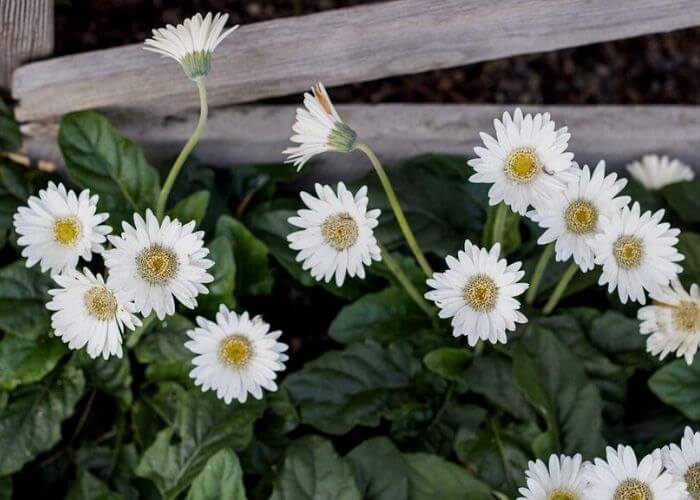
Having seen some pink gerbera daisies, here is a white one for you. This gerbera has a pure white set of outer petals that overlap, and a yellow disk, which may remind you of a large sister of the common daisy, as the flowers reach 2 inches in diameter (5 cm).
This plant too will bloom from late spring to fall, and each plant will regale you with up to 100 flowers during the long blooming season.
Rather short as a plant, it will look great at the front of flower beds and borders, but also in containers and pots.
11. Gerbera Daisy ‘Revolution Bicolor Red Lemon’ (Gerbera Jamesonii ‘Revolution Bicolor Red Lemon’)
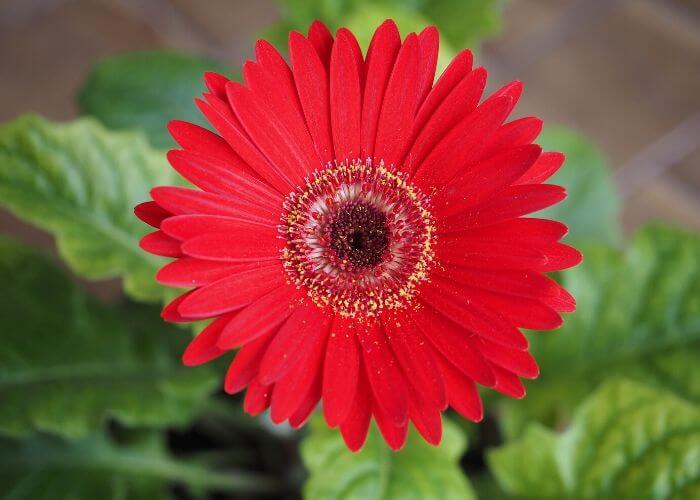
The name of this cultivar, gerbera daisy ‘Revolution Bicolor Red Lemon’ says it all. A stunning variety with petals that start of a light lemon, almost white color, and then turn into a vibrant candy apple red, this is a plant that’s as eye catching as it gets.
The leaves are very long too, etching 10 inches in length (25 cm), adding to the decorative value of the showy flower, which can be 4 inches across (10 cm).
This makes it excellent if you want to add a touch of fiery red to your flower beds, borders or containers, as it will draw attention from anyone who visits your garden. Plant it in focal points to increase your garden’s perspective.
12. Gerbera Daisy ‘Mega Revolution Champagne’ (Gerbera Jamesonii ‘Mega Revolution Champagne’)
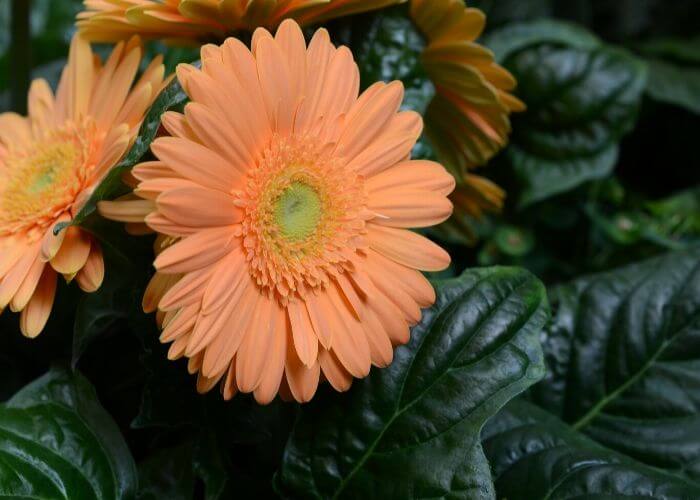
This must be the most romantic of all gerbera daisies, with a pastel champagne color and petals that start long at the back and become shorter as you approach the disk. The disk itself is pink with some yellow tips, which only brings extra light to this already beautiful flower.
It is a perfect flower to bring a feeling of melancholy and of delicate romance to your garden, in borders, beds or containers.
13. Gerbera Daisy ‘Sweet Surprise’ (Gerbera Garvinea ‘Sweet Surprise’)
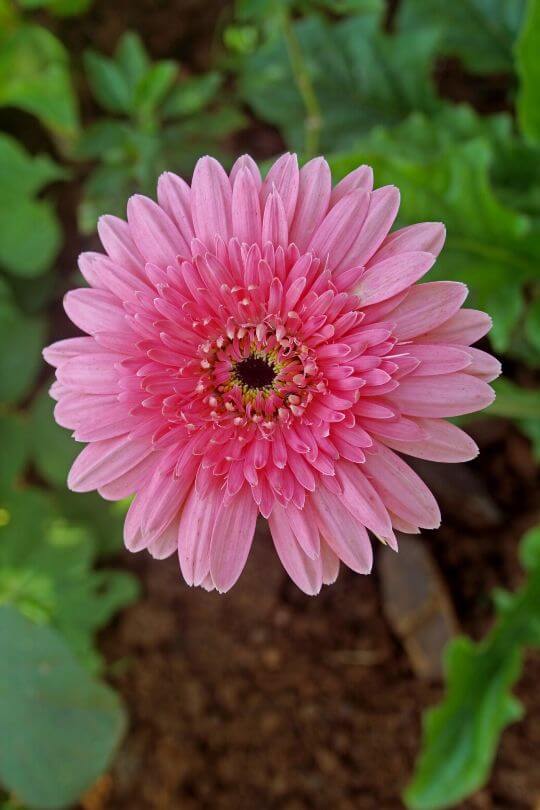
Let’s finish our lust of gerbera daisies with a particularly brightly colored variety, the shiny fuchsia to magenta purple petaled gerbera ‘Sweet Surprise’.
And a surprise it is indeed, with many rows of petals which are long straight, decreasing in length as you approach the disk, where they then turn white at the tips.
The very vibrant color of this gerbera makes it ideal if you want to give some light and energy to your flower beds, borders or if you want a container that no one can miss on your terrace or patio.
Shasta and Bellis Daisies
I have grouped two types of daisies together, Bellis and Shasta, because they do have varieties within them, but they are mainly used for prairies, lawn or similar settings, and they have a big feature in common: they usually have white petals and a yellow disk.
Both very popular, Bellis is actually smaller, while Shasta also adapts to borders me flowerbeds because it is of a larger size.
14. Shasta Daisy ‘Snowcap’ (Leucanthemum X Superbum ‘Snowcap’)
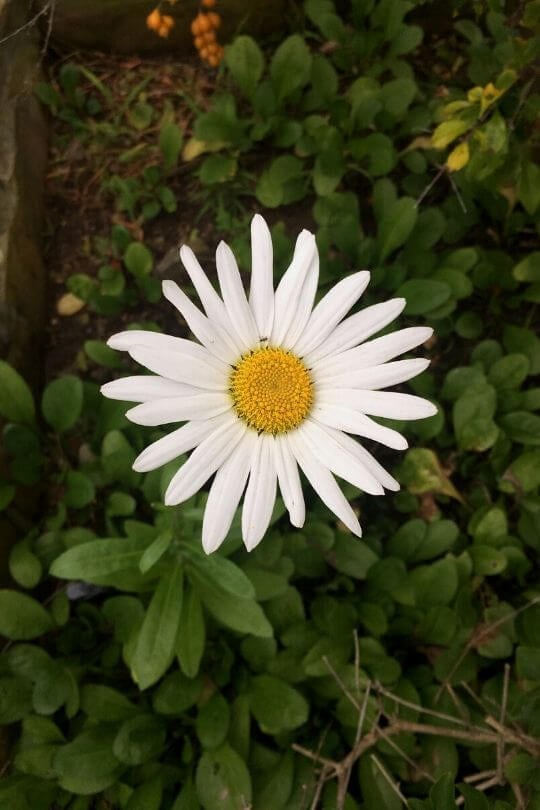
A classical Shasta daisy, ‘Snowcap’ is a variety that will produce a sea of white flowers with golden yellow disks which will attract butterflies, bees and pollinators through the summer.
Taller than the classical prairie daisy, this variety can also be used for borders and flower beds, but it would not look amiss, mixed with other wild looking flowers, in a meadow or prairie.
It is an extremely popular variety which you can find in gardens all over the world, also because it tolerates drought, heat as well as excessive moisture.
15. English Daisy ‘Pomponette’ (Bellis Perennis ‘Ponponette’)
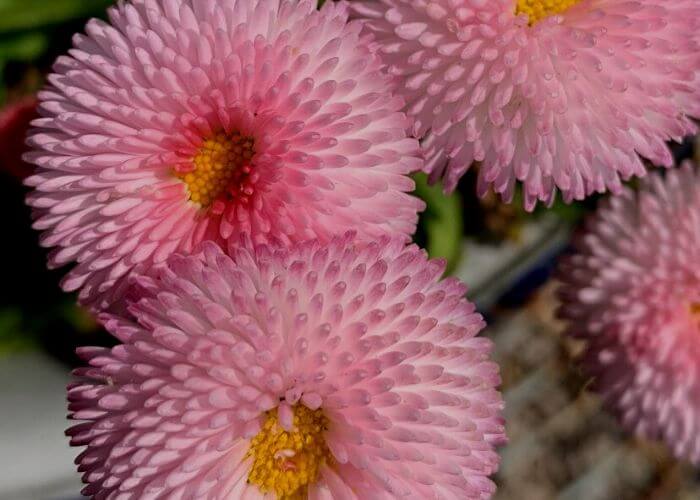
We have already met the most classical of all daisies, the common daisy or English daisy… But there’s a cultivar that I want to introduce to you: ‘Pomponette’.
This is a small flower that diverts from the mother species because, well, it has multiple flowers, with so many well arranged petals that they end up looking like balls, and because they have pink petals in the middle.
So, this praise, unlike the simple Bellis perennis, can be planted outside wild meadows, lawns and prairies and become part of your borders, beds and even a nice, playful and sweet companion to your spring and summer afternoons in a pot on your terrace.
African Daisies
Arctotis Daisies commonly known as African daisies are distinct because of their bright colors and elegant and waxy petals. They usually have few low leaves, which allow the flower to take center stage in the way these daisies present themselves.
The petals have very clear, defined shapes, which makes it one of the most architectural daises on the market.
African daisies are actually flowers from two genera of daisies called Arctotis and Osteospermum, both members of the Asteraceae family, or what we commonly call “asters”.
These too, like chrysanthemums are actually daisies, but, because they have developed into groups of their own for gardeners, and they are so many, we will see them maybe another time.
16. African Daisy The Ravers ‘Pumpkin Pie’ (Arctotis ‘Pumpkin Pie’)
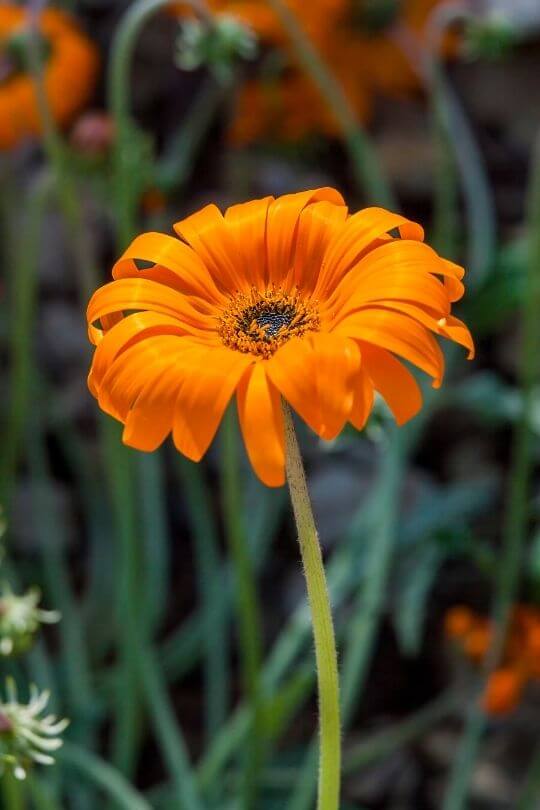
With velvety bright and deep red, perfectly arranged petals with straight ribs along them, a ring of yellow quiffs around the disk and then a dark blue to black center, I am sure you will appreciate the striking effect this flower can have in your garden!
It will keep blossoming from late spring till the first frost tells it to stop, keeping the energy levels of your border, flower bed, pots or terrace as very high with its impressively vibrant colors!
17. African Daisy ‘Wine’ (Arctotis X Hybrida ‘Wine’)
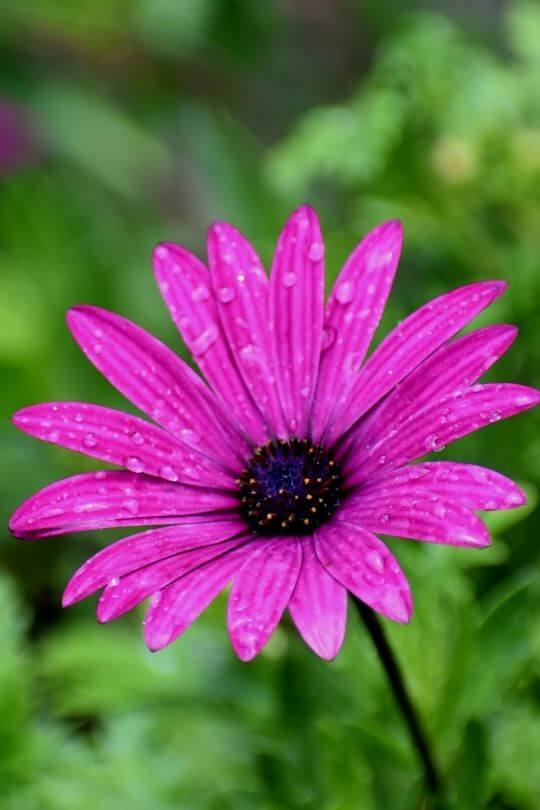
With long, pointed petals that give this flower a star shape, and with a coloring that is both striking and elegant, African daisy ‘Wine’ can bring a touch of exotic beauty to your borders, beds and pots.
The flowers will “hover” above the foliage, which will remain a few inches below them, and you will not miss them, because they can be wholly bright pink, or white with pink patches on them. At times, they have a small yellow ring around the disk, which is of an off white, almost grayish color.
18. African Daisy ‘Flame’ (Arctotis X Hybrida ‘Flame’)
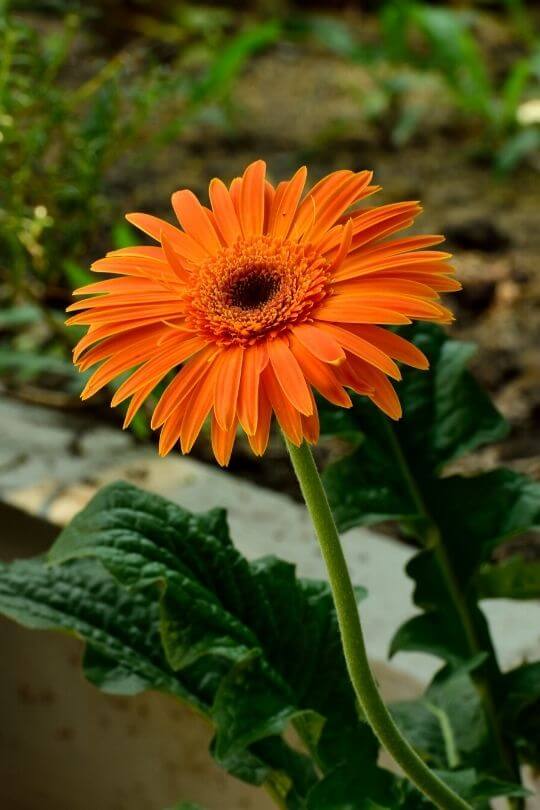
Winner of the Award of Garden Merit of the Royal Horticultural Society, African daisy ‘Flame’ is a stunning flower, with flaming copper orange petals in a star shaped arrangement and a greenish yellow disk. This is a plant that spells “class” and “bold” at the same time.
Maybe one of the best flowers to add that touch of African art, with its striking lines and strong, uncompromising colors to your patio, flower beds, terrace, borders or even rock gardens.
19. African Daisy ‘Lemon Symphony’ (Osteospermum ‘Lemon Symphony’)
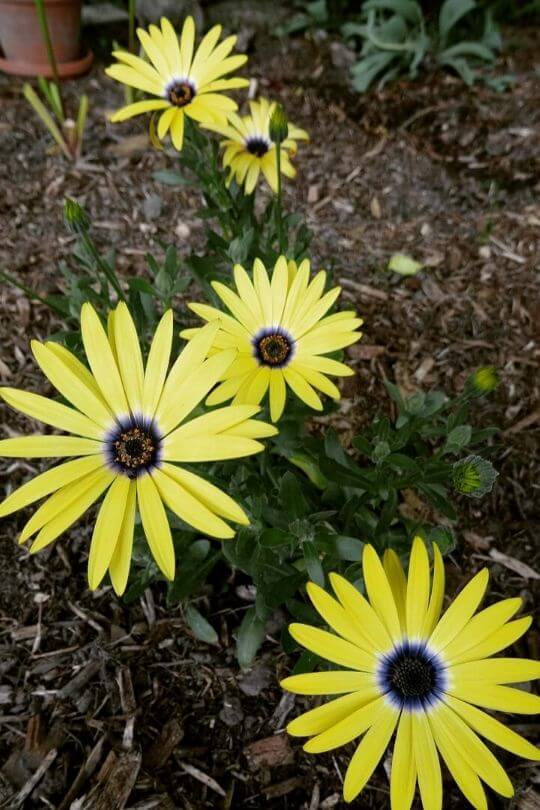
Imagine a beautiful flower with very waxy, daisy like petals… Imagine they are perfectly arranged to form a star. Imagine then that these long petals turn white and then purple to form two rings around a small orange disk… Done? You have imagines African daisy ‘Lemon Symphony’, one of the most strikingly beautiful African daisies in my view.
This amazing daisy also has a strange behavior; it will start its amazing blooms in spring, then, when it gets hot, it will just stop and wait… But as the temperature drops and fall approaches, it will start flowering again…
Because of the high decorative quality of this flower, I would put it in full view, maybe even close to eye level, whether in pots or in raised position in your borders, flower beds or rock garden, because this is a flower that demands to be admired.
20. African Daisy ‘Serenity Pink Magic’ (Osteospermum ‘Serenity Pink Magic’)
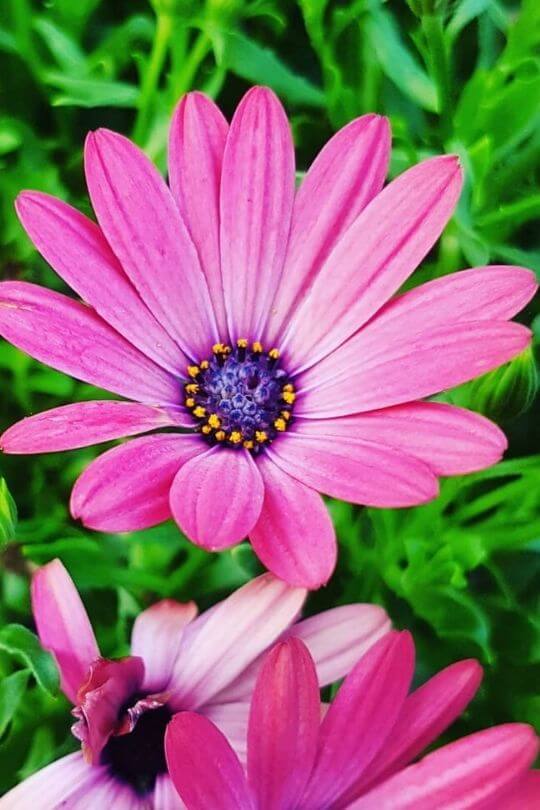
This African daisy is pure romantic magic! With two rows of elegant petals that start of a richer rose shade that gently fade to white towards the center, then a ring of gold around a dark purplish disk, these flowers just draw you in, as if wishing to embrace you with their beauty and warmth.
Where the climate is good for this African daisy, which likes cool summers, these sweethearts will keep blossoming from early spring to frost.
I can see it well in a sunny spot by a bench, where you can withdraw for romantic moments among flowers like this, that speak of dreamy passion from pots, in flower beds, or, if you wish as the romantic stars of your borders.
21. African Daisy ‘Zion Copper Amethyst’ (Osteospermum ‘Zion Copper Amethyst)
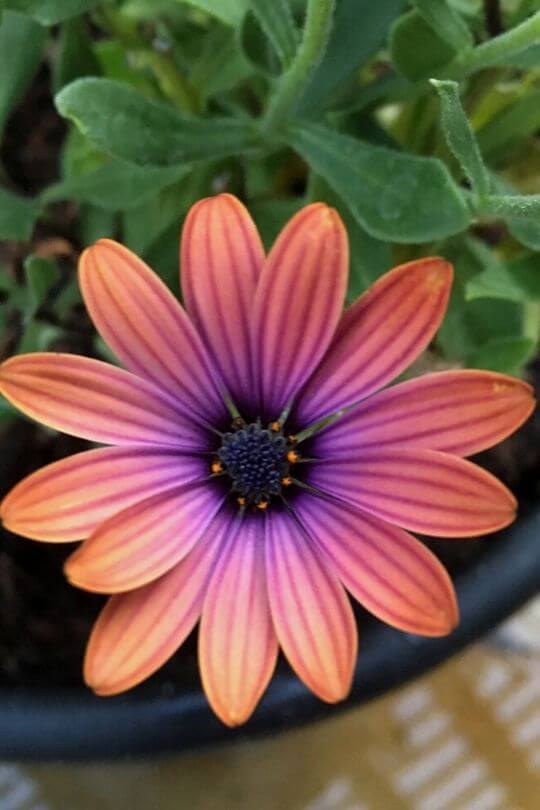
Wow! This Africa daisy will literally take your breath away, and it can become the great protagonist of your flower beds or borders. With a very round crown of petals that start flaming copper orange at the rips, then turn crimson red, then shade into a very vibrant, almost shocking pink and finally turn into tow shades of purple, this flower will look like it has just landed in your garden from outer space!
The crown has a ring of golden yellow dots and then a dark purple centre, making it a wonderful focal point for the literally impressive look of this African daisy. And… it will blossom from spring all the way to the first frost!
Gloriosa Daisies
Known to scientists as Rudbeckia, this genus of plants from North America has found its home in many gardens around the world thanks to its sunny colors.
With strong colors that go from dark red to bright yellow in many combinations, it will remind you a bit of those colorful clothes and patterns that the Aztec and Maya used to weave.
This genus too is a member of the Asteraceae family, but it also has a semi-spherical, rounded central disk that sets it apart from many other daisies.
22. Black-Eyed Susan ‘Indian Summer’ (Rudbeckia Hirta ‘Indian Summer’)
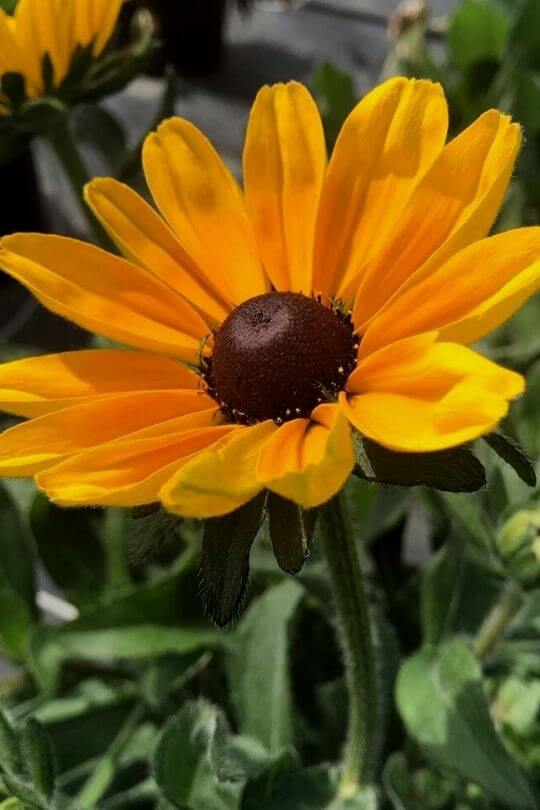
Called “black-eyed Susan” because the disk is of a range of dark purple shades, form deep violet to burgundy, which look black from a distance and a crown of perfectly shaped, yellow petals that are lighter in the outer part and turn almost light orange in the inner half, this daisy looks like the Sun has taken home in your garden.
With longer blooms than other gloriosa daisies, it will keep this energetic and vibrant color in your prairie or wild meadow (where it just looks stunning), borders or beds from the beginning of summer all through the fall.
No wonder it has won both the All-America Selection Award in 1995 and of the Award of Garden Merit of the Royal horticultural Society in the year 2000.
23. Black-Eyed Susan ‘Summerina Orange’ (Rubdeckia ‘Summerina Orange’)
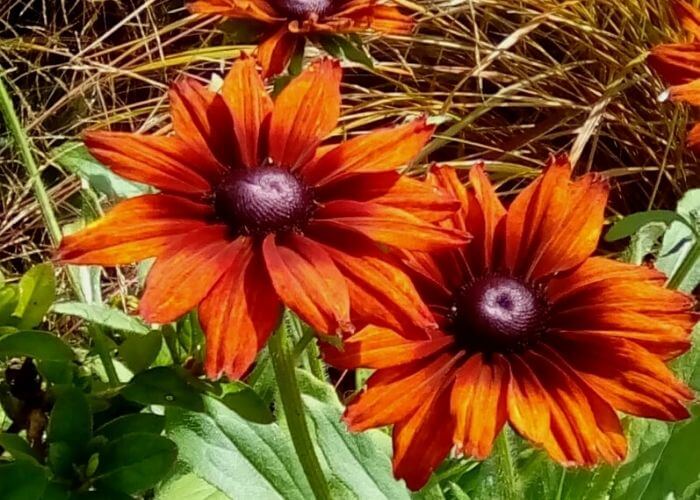
If you prefer a more passionate, even more fiery and sultry look if your garden, then the warm and deep colors of this gloriosa daisy, Black-eyed Susan ‘Summerina Orange’ are just perfect for you!
With a purple raised disk, which shades from burgundy to violet towards the center, then the petals that start very deep red, then shade all the way to orange or even yellow, these flowers just look like many bonfires scattered around your wild meadow, borders or they can bring to life your flower beds in large clusters of warmth and energy.
24. Black-Eyed Susan ‘Cherry Brandy’ (Rudbeckia Hirta ‘Cherry Brandy’)
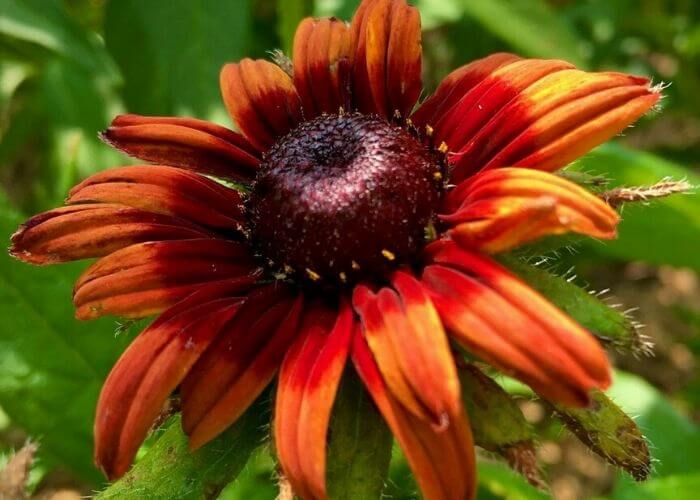
How about conveying that feeling of extremely warm, fiery passion to your garden with Black-eyed Susan ‘Cherry Brandy’? This variety has darker colors than the other gloriosa daisies we have seen, bringing forth shades of red rather than yellow and and orange.
With a dark raised purple disk and petals that gradually turn from deep cherry red to bright ruby, this is the daisy you want if you wish to add depth, of feeling as well as in visual terms to your garden.
Plant it at the middle or back of borders to draw the eye in, or at the front to frame them, if you want a bold architectural look for your beds me borders, no you will never regret choosing this plant.
Marguerite Daisies
Marguerite is a word that comes from the Latin for “pearl”, which has, in some country, come to mean daisy itself (like in Italy).
The whiteness of pearls, however, is a bit reductive for the palette of the Argyranthemum, Anthemis and Felicia, the three main genera of daisies we call by the name “marguerite”.
These flowers, in fact, that can be white, yellow, shaded and even blue, but they all have that innocent, pure look that we associate with classical daisies.
Here are some popular cultivars:
25. Blue Daisy (Felicia Amelloides)
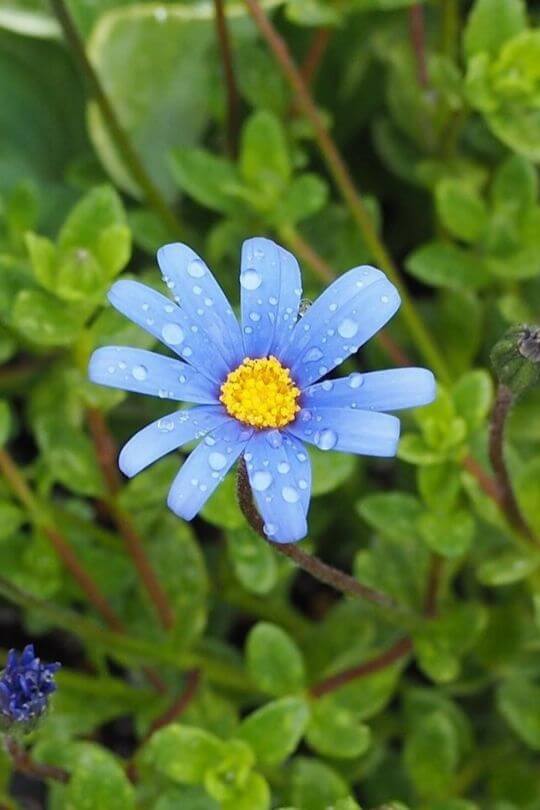
Here is a wonderful marguerite daisy with that sky blue color that will send you straight into your childhood days…
With long, light blue de France petals that look like heaven itself and a central bright yellow disk, growing this flower in large clump, shrubs or patches is like bringing a bit of the sky down to earth…
A good carpeting plant, it will also attract butterflies whether you grow in in wild meadows, borders or beds, but you can also enjoy its innocent beauty if you grow it in pots for a long time, as it will blossom from early summer to the beginning of fall.
26. Golden Marguerite (Anthemis Tinctoria ‘Kelwayii’)
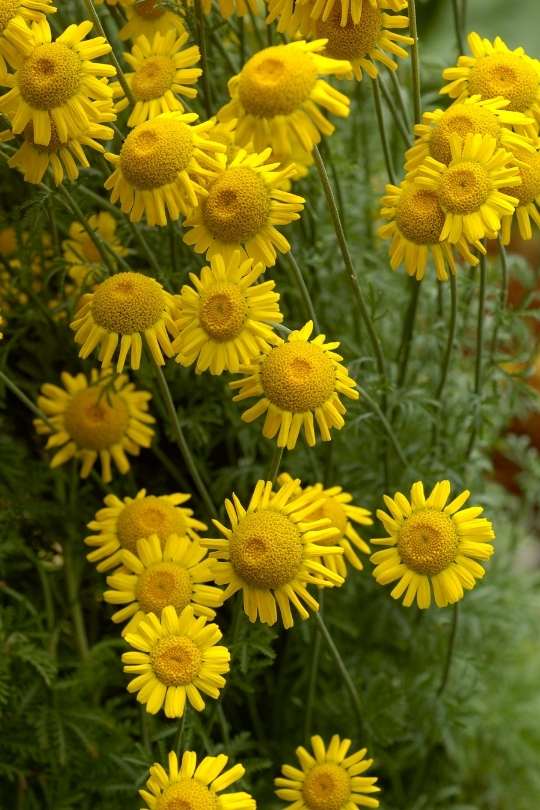
This marguerite has bright yellow petals with a darker and raised disk in the middle. It grows fast and it blossoms very profusely, creating a sea of vibrant yellow that will almost completely cover the foliage, but not your nose, as the leaves of golden marguerite are actually very aromatic!
So, if you want a garden that smells nice and looks impressive, cover slopes, edge borders or even fill pots with this bright and lively daisy, and just watch it blossom for the whole summer season, while in winter, the perfumed leaves will still proved some interesting green.
27. Golden Chamomile ‘Sauce Hollandaise’ (Anthemis Tinctoria ‘Sauce Hollandaise’)
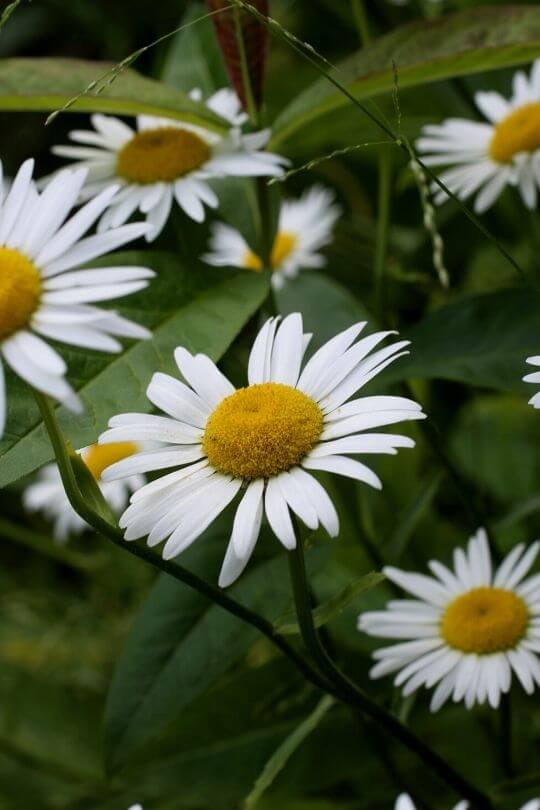
This marguerite too has nicely scented foliage, and this too will cover it with stunning and thick blooms, but this time, they will have a bright yellow disk in the center and Snow White petals all around, which make it look a bit like chamomile.
So, if you want your own chamomile looking field, which brings peace only mentioning it, or you want a great flower to scatter in your wild prairie or cottage garden beds, this strong perennial daisy may just be what you have been looking for.
Considering all gardeners know that growing earl chamomile is quite hard (though it grows so well spontaneously), you may wish to go for golden chamomile instead.
28. Marguerite ‘Pure White Butterfly’ (Argyranthemum Fructescens ‘Pure White Butterfly’)
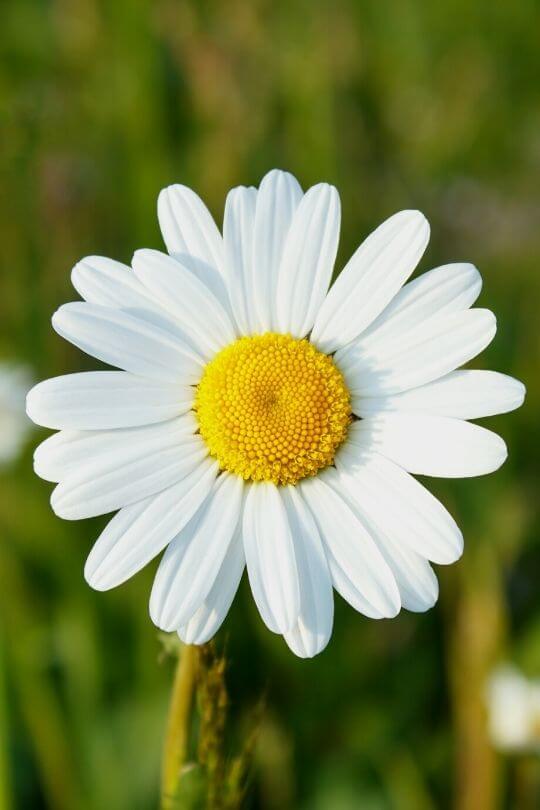
Also known as Paris daisy ‘Pure White Butterfly’, this marguerite too, like ‘Sauce Hollandaise’ looks a bit like chamomile, but it is taller, with a shrubby appearance and its flowers are more showy and they will start blossoming in spring and continue all the way through the end of summer.
Very generous too with its flowering, gardeners often choose to grow this short lived perennial because of the thickness of the flowers, which will cover the leaves almost in full. This makes it good for many places in your garden, from pots to borders.
29. Marguerite ‘Golden Butterfly’ (Argyranthemum Frutescens ‘Golden Butterfly’)
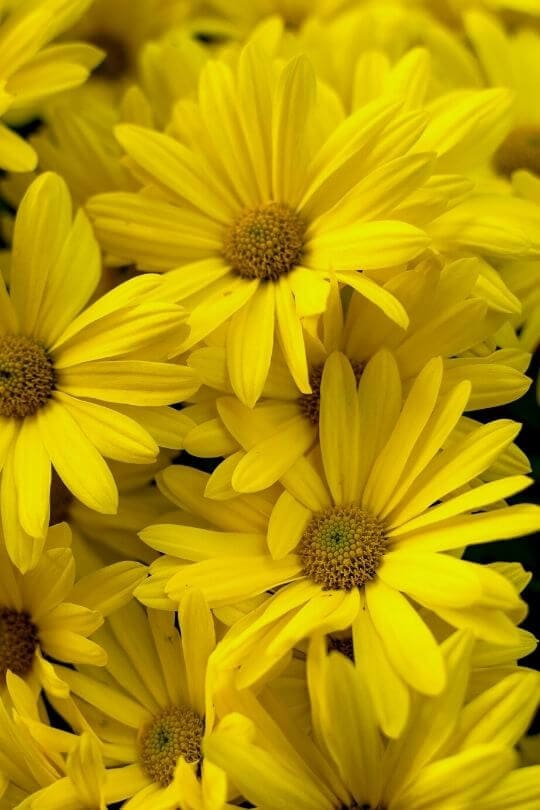
This close relative to ‘Pure White Butterfly’, you will prefer marguerite ‘Golden Butterfly’ if you need a carpet of bright yellow flowers in your garden, which will also last longer than the cultivar in white and yellow, as it will start in spring and keep filling your chosen spot with rich, intense yellow flowers all the way to the first frost!
This flower can sort out your neglected border in no time at all thanks to the generosity of its blooms, to its evergreen foliage and the fact that it is low maintenance and it grows quite fast.
30. Marguerite ‘Vanilla Butterfly’ (Argyranthemum Frutescens ‘Vanilla Butterfly’)
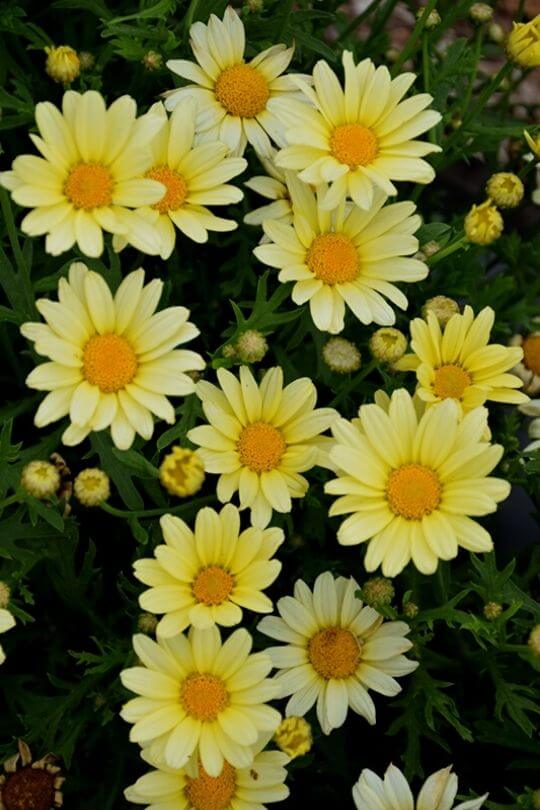
Image Source- https://plants.buyallseasons.com
I thought it would be nice to close on fading with an article on such innocent looking and delicate flowers as daisies. So, this variety is a bit a combination of the shades of the previous two marguerite daisies: it has an ochre yellow disk in the center and then, the petals start with a bright yellow ring, but they soon turn white.
This is a flower to admire in peace and calm, with a very subtle, but elegant and delicate effect. On the other hand, this beautiful daisy will not be holding back blooms as it will flower from late spring till fall, and this too will cover all its foliage with flowers, whether you grow in in flower beds, borders or pots.
On the whole, this is a perfect choice if you want a delicate “country feel” in an informal garden.
So Many Daisies to Choose from!
Amazing, isn’t it? There are so many beautiful flowers among daisies that these thirty only represent a very tiny fraction… I couldn’t possibly cover all the types of daises in this article and had to leave so many out… But I chose some of the most beautiful and popular, and, as you can see, daisies are not just white, and daisies are not just small…
There are big ones, showy ones, exotic looking ones, daisies with waxy petals, tiny plants and even fairly large shrubs. But what is more, you can find daisies for small pots or large borders, for formal gardens or wild prairies, for romantic corners or seas of energy and passion… And I just hope this article has helped you with your choice of daisies.

Written By
Adriano Bulla
After many years as an academic in London, Adriano Bulla became a writer, publishing books like A History of Gardening, Organic Gardening and Elements of Garden Design; he then decided to become a gardener, following his childhood dream, and has been following his dream writing and gardening professionally in Southern Europe, where he has specialized in new and innovative organic gardening fields and techniques, like permaculture, regenerative agriculture, food forests and hydroponics.
